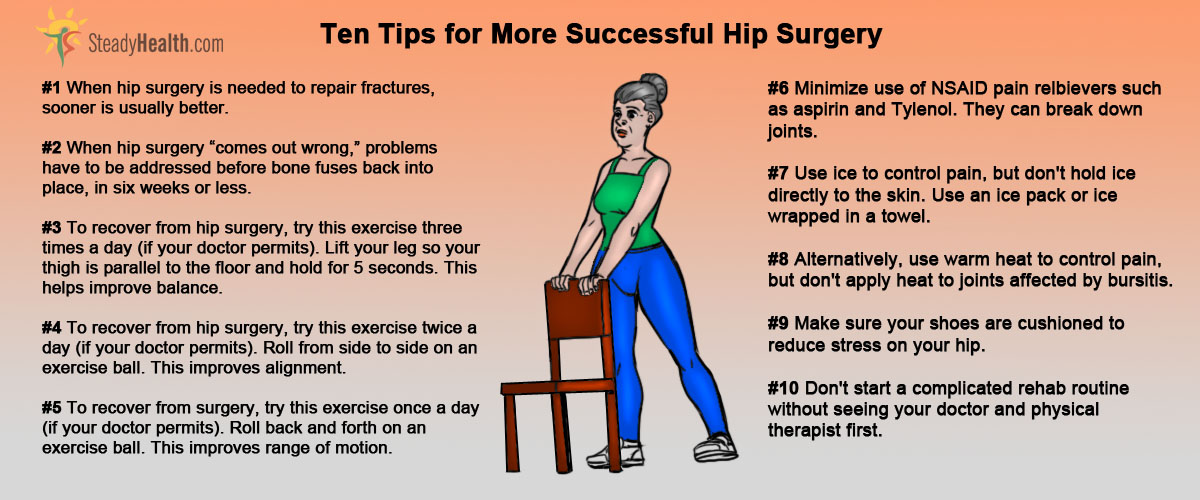One of the most common questions in the Steady Health forums is how to manage pain after hip replacement surgery:
- What is causing severe leg pain after my friend's hip replacement surgery?
- Is it normal for one leg to be longer than another after hip replacement surgery?
- What causes pain in the groin after hip replacement surgery?
- I had hip replacement surgery because I was in pain all the time, why won't the pain go away now?
And fortunately thousands of members help each other find answers. Today, however, we would like to address the things that can be done before hip replacement surgery to make the operation go more smoothly. Most of these suggestions are matters hip replacement recipients will have to discuss with their doctors, but all of them can make a real difference in the outcome of the procedure.
The sooner the surgery for hip fractures, the better the outcome
Broken hips need to be repaired right away. Canadian surgeons studied post-surgical records of hip fracture patients who were fast-tracked for surgery, receiving surgery on average just 6 hours after being brought to the hospital, and patients who had to wait 24 hours or more for fracture repair. Both groups had complications, but only 30% of fast-tracked patients had complications compared to 47% of patients who had to wait.
Hip replacement surgery often results in uneven leg length. When this happens, it needs to be addressed quickly
About 1/3 of all hip replacement operations result in pressure on the femur that causes on leg to become longer than the other. Typically the different in leg lengths after the surgery is 1-2 inches (25 to 50 mm). If the problem is not addressed in the first few weeks after surgery, it can become permanent, resulting in permanent hip and back pain. If surgery is impossible, sometimes it is possible to wear an "elevator shoe" on foot, but usually the surgeon will operate on the heel to correct the length of the leg.
Revision surgery on the hip itself must be performed in the first six weeks, before the bone has had a chance to fuse.
See Also: A New Way To Get A New Hip
If you don't have hip problems yet - and don't try this if you do - practice BAM-321 to prevent future hip issues.
Poor posture places stress on joints all over the body, especially on the spine and hip. Dr. Steven Weiniger, a posture expert at BodyZone, LLC, recommend a daily exercise routine he calls BAM-321 (balance three times a day, alignment two times a day, and motion once a day) to keep the muscles surrounding the hip joint strong.
- Three times a day, lift your thigh so it is parallel to the ground or floor, while holding to a wall for support. Maintain this position to a count of five. This exercise improve balance.
- Two times a day, move side to side while sitting on a balance ball. This improves alignment.
- Once a day, move back and forth while sitting on the balance ball. This helps maintain mobility and range of motion.
Twelve Tips For A Daily Routine For Dealing With Hip Pain
The hip is the largest joint in the human body. Because it must support the body's weight, it is subject to constant stress. Chronic pain in the hip joint is not unusual as the body ages, but there are changes in lifestyle that can make a huge difference in managing hip pain. These tips work whether you just have a problem with chronic hip pain or you have already had hip surgery, but speak with your physician and physical therapist before trying them if you had had surgery on your hip.

- Get a medical diagnosis before attempting anything else. It is important to know what is causing your hip pain so (1) it can be treated and (2) you will not inadvertently incorporate an exercise into your daily routine that might accidentally make the problem even worse.
- Minimize your use of pain relieving medications. Many of the over the counter NSAID pain relievers such as Aspirin and Tylenol and similar products have a nasty, underpublicized side effect. They actually accelerate the breakdown of cartilage that accelerates the pain they relieve. Prescription drugs such as Vicodin and Oxycodone are problematic, too. It is simply best to reduce pain without medications to the greatest extent possible.
- Ice painful joints. Holding ice packs or cold packs to your hip for up to 15 minutes at a time will reduce pain. Don't place ice or cold packs directly on the skin. Insulate them with a towel. There will be less melt and less risk of freezing your skin.
- Ease pain with moist heat, such as a soothing warm shower or bath. However, if you have bursitis (see point #1 above, see a doctor first to get your diagnosis), avoid heat, which can actually make bursitis worse.
- Rest your hip after injury. If you sprain or strain a muscle around your hip, stay off your feet as much as possible for 24 to 48 hours to let the injury heal.
- Consider losing weight. The less you weigh, the less the load on your hip joints.
- Make sure your shoes cushion your weight. The more support you get from your shoes, the less stress you place on your hips.
- Avoid contact sports. Weakened hip muscles sometimes simply cannot take rough and tumble athletic contact.
- Begin every day with a bridge exercise. Lying down, press down at your shoulder blades and ankles and lift your hips gently, holding the position 3 to 5 times. If the exercise does not increase pain, repeat up to 10 times.
- Exercise in water. Exercise in water is a great way to exercise hip muscles without putting unnecessary pressure on them. Swimming is helpful, as are stretching exercises performed in warm water.
- Strengthen you abductor muscles with this exercise. Stand up straight, and lift your right leg in front of you as high as you can. Lower it, and repeat with your left leg. Do this exercise holding on to a bar, a door, or a secure wall fixture if necessary.
- Speak with a physical therapist about hip rotation exercise, hip flexion exercises, and glute squeezes. Not everyone is ready for these exercises and you should not attempt them if your hip joint or the muscles around it have been seriously injured and you are still recovering.
See Also: Hip Dysplasia - An Overview
Physical therapy, initiated early in the recovery phase, plays a pivotal role in enhancing mobility and strengthening the muscles surrounding the hip joint. Regular sessions under the guidance of a licensed therapist can aid in regaining range of motion and decreasing post-operative stiffness.
Nutrition shouldn't be overlooked. A diet rich in protein, vitamins C and D, calcium, and antioxidants can significantly support tissue repair and bone health. Patients should consider integrating lean meats, dairy, citrus fruits, berries, leafy greens, and whole grains into their daily regimen. Staying hydrated is equally important, as water aids in the transport of essential nutrients and the elimination of post-surgical waste products.
Regularly scheduled follow-up appointments with the surgeon will help monitor progress and address any potential complications. During these visits, patients can discuss concerns, adjust pain medications, and modify rehabilitation strategies if necessary.
Lifestyle modifications can also contribute to a smoother recovery. Using assistive devices, such as walkers or canes, especially in the early stages, can offer added stability. Engaging in low-impact activities, such as swimming or cycling, once cleared by the healthcare provider, can further facilitate joint flexibility and muscle strength.
Lastly, the emotional aspect of recovery must be addressed. Maintaining a positive mindset, setting realistic expectations, and seeking support through loved ones or support groups can significantly impact the healing trajectory.
While hip surgery can be a significant life event, adopting a comprehensive and proactive recovery strategy ensures not only quicker healing but also a robust return to an active and fulfilling life.
- Hip Fracture Accelerated Surgical Treatment and Care Track (HIP ATTACK) Investigators. Accelerated care versus standard care among patients with hip fracture: the HIP ATTACK pilot trial. CMAJ. 2014 Jan 7, 186(1):E52-60. doi: 10.1503/cmaj.130901. Epub 2013 Nov 18.
- Mindmap by steadyhealth.com
- Photo courtesy of Quinn Dombrowski by Flickr : www.flickr.com/photos/quinnanya/3515344309



Your thoughts on this